- Offensive Techniques & Strategies
Basketball Defenses
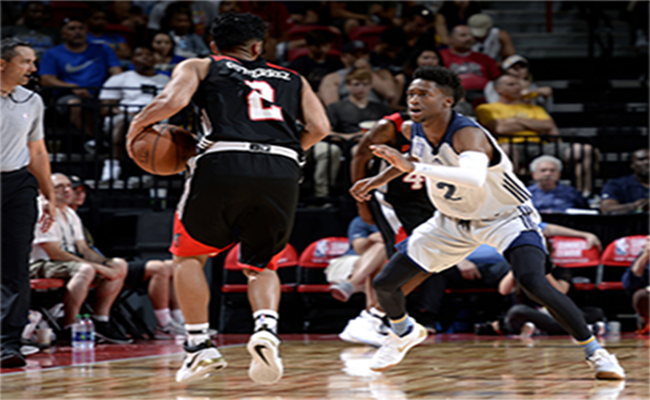
The game of basketball allows a variety of defenses to be deployed in an effort to disrupt and combat offensive plays. Here are examples of the three basic categories of team defenses. In addition, each category is comprised of an assortment of different variations.
| Person-to-Person | Zone Defenses | Combination Defenses | Presses | About Defenses |

Person-To-Person Defenses
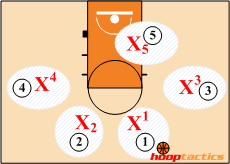
Person-to-Person defenses match up the defenders against specific offensive players. Defenders are usually assigned to be matched up with offensive players by size and ability. Basically, there are three types of Person-to-Person defenses: Straight, switching and sagging. The specific type used in a game primarily depends on a team's player personnel. There are three types of person-to person defenses: Straight, Switching, and Sagging.
Straight Person-To-Person
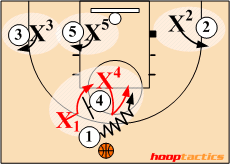
Straight person-to-person is an aggressive defense which causes severe problems to good spot up shooters and poor ball handlers. In this type of defense, defenders will fight over screens. However, it can be susceptible to dribble penetration and on ball screens.
Switching Person-To-Person

The ability to attack passing lanes make switching person-to-person defenses an ideal defense to use against motion type offenses. In this type of defense, defenders will aggressively switch on all contact screens. The disadvantage to switching is that, in some cases, it can cause severe mismatches.
Sagging Person-To-Person
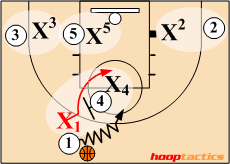
Sagging person-to-person defense can be very successful against poor outside shooting teams and against dribble penetration. In this type of defense, the defenders will go behind or switch most screens. However, it is susceptible to good outside shooting teams.

Zone Defenses

With Zone defenses, defenders are assigned to guard specific areas on the court. Zones are named or designated by their player alignments and vary in strengths and weaknesses.
2-3 Zone
The two-three zone player alignment consists of two players positioned just above the free throw line and three players stationed along the baseline.
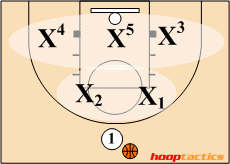
Strength: Baseline & Rebounding
Weakness: Wings & Top of the Circle
2-1-2 Zone
The Two-One-Two zone has a similar player alignment as the two-three zone, except that the middle baseline player assumes a high position just below the free throw line.
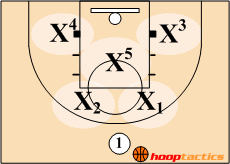
Strength: Middle & Three Second Area
Weakness: Wings, Corners & Top of the Circle
1-2-2 Zone
The One-Two-Two or "Jug" zone player alignment consists of one player at the top of the circle, two players on the wings, and two players on the baseline.
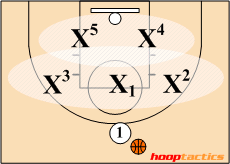
Strength: Outside
Weakness: Middle & Corners
3-2 Zone
The Three-Two Zone is similar to the One-Two-Two zone except that the point defender drops back to the free throw line. This allows the wings to exert more pressure.

Strength: Across Free Throw Line
Weakness: Top of Circle & Corners
1-3-1 Zone
The One-Three-One Zone consists of a point station at the top of the circle, three players position across the free throw line and one player in front of the basket.
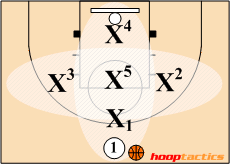
Strength: Across Free Throw Line & Top of Circle
Weakness: Corners
Match-Up Zone
The Match-Up zone can be ran out of either a two-three or one-three-one initial alignment, but assumes whatever form it takes to match the offensive alignment.
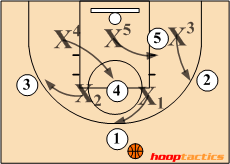
Strength: Matching offensive alignments
Weakness: Cutters

Combination Defenses
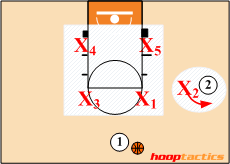
A third type of defense that can be deployed is the combination or "Nickel" defense. With combination defenses, some of the players are assigned to play person-to-person while the rest of the defenders play zone. Combination defenses are usually deployed in an effort to stop or neutralize great individual offensive players. They can be very effective against any team not prepared to attack them. However, they do have vulnerabilities and, as a result, are not normally deployed as a primary team defense. Here are some examples of combination defenses.
Box & One
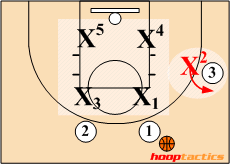
Probably the most common combination defense is the "Box & One" defense. Here, four defenders form a box zone and the fifth defender plays a strong pass denial on a designated player.
Diamond & One
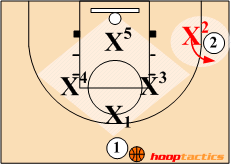
The Diamond & One defense is a variation of the box and one used when opponents employ a single guard front offensive alignment.
Triangle & Two
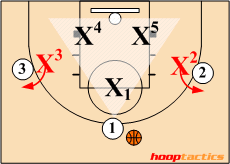
In this combination defense, two defenders assume strong pass denial positions against designated offensive players. The other three defenders form a triangle zone.
Combo
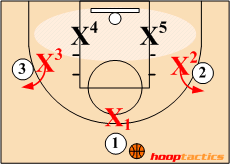
The combo defense is a combination zone inside and person-to-person outside. The three outside defenders assume strong pass denial positions. And the two inside players zone on the baseline much like a 1-2-2 zone. The combo defense is usually used against a penetrating, spread offense such as the "North Carolina Four Corners" offense.
A complete study of combination defense can be found in the HoopTactics' "Defensive Strategies" presentations. Be sure to check them out.
Full Court Extensions

Both person-to-person and zone defenses can also be extended into full, three quarters or half court presses.

Things to Consider About Defense
-
Poor defense is the number one cause of defeat.
Good defensive teams are the ones that win big games and championships.
Defense is stable, and seldom has bad nights.
Team defense cannot be better than the defense of each individual.
-
Ball Pressure is the single most important element of team defense. Pressuring the player with the ball makes passing and dribbling more difficult, and increases the chances of an offensive mistake.
Good defensive effort usually results in more playing time.
Defend every play with the same intensity as the last play of the game.
-
You are never too late on defense - always hustle back. NEVER run back on defense with their backs to the ball.
-
Maintain vision on the ball handler. Most passers telegraph their passes.
Be aggressive and prevent the opponent from playing their normal game.
-
Be alert and anticipate. Never be caught standing or watching. Good defense promotes most of the best scoring opportunities.
Communicating on defense is a must. Use quick words (“Ball”, “Jam”, “Shot”, etc.)
-
Have active feet. Never get caught standing flat footed. Fight for good position and eliminate defensive fouls.
Take full advantage of the out of bounds lines. They are great defenders that never make any mistakes.
-
Pressure all shots with both hands up. Close out to outside shooters quickly on balance. NEVER run past a shooter or leave your feet. Stay down, box out and rebound.
-
Anticipate and take offensive charges. They are “Really Big Plays” (RBP) in basketball. They not only take away potential baskets and create offensive turnovers, but also assess the offensive players with an additional penalty of a personal foul.
Post defense is not just limited to the tallest players on a team; on the contrary, smaller players can definitely expect to be posted up.
Develop individual and team pride on defense. To be successful players must work together and help each other out.
-
Fight for good position and eliminate defensive fouls. Defend with your legs feet and don’t reach.
-
Never give up the three point play. If you must foul, do so before the player shoots.
-
Tenacious defensive players will never let up during the entire game. They challenge every shot, pass, dribble and cut.
The “best defense” is an offensive rebound.
To view the current basketball rules - Click Here
Return to Basketball Basics' Main Menu - Click Here
© 2026 HoopTactics All Rights Reserved.
